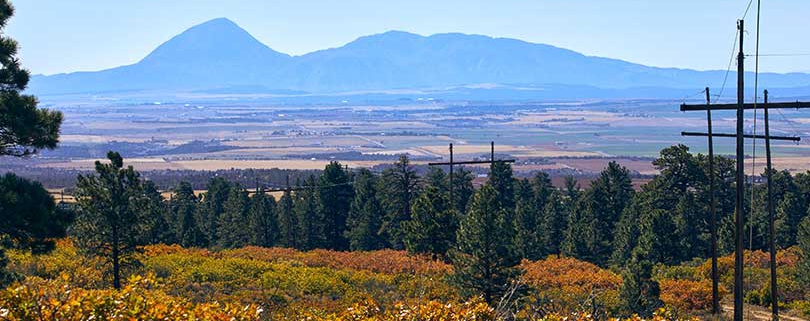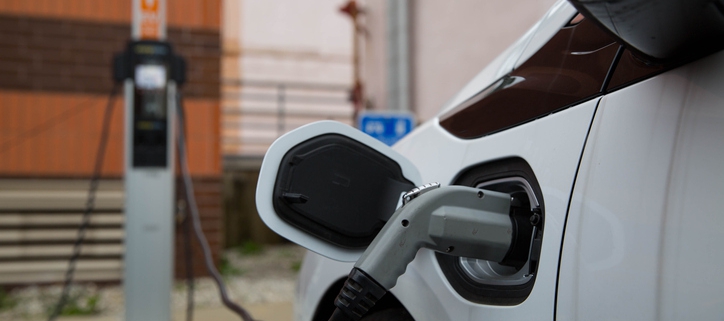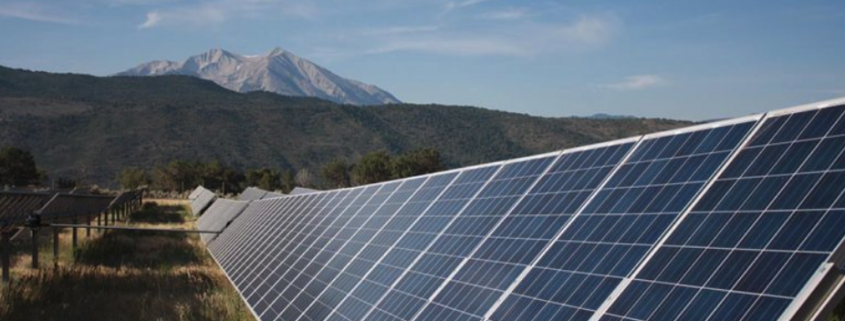Transmission Project Crosses the Canyon
By Jonah Martin, Manager, MNC Project Management Office
Even by the standards of other major utility construction projects across the nation, the numbers behind Tri-State Generation and Transmission’s recently completed, 230-kilovolt Montrose-Nucla-Cahone (MNC) transmission project are staggering. Throw in a worldwide pandemic during the construction phase and we have a real story to tell.
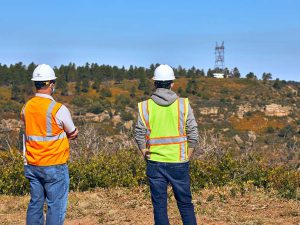
Two Tri-State Generation and Transmission staff view the process of the Montrose-Nucla-Cahone transmission project. The project cost nearly $105 million and 65,000 labor hours of construction.
The basic facts are impressive for a project built in remote areas of the Rocky Mountain West. The project began in May 2013 and required the approval of nearly a dozen local, state and federal agencies, including the U.S. Bureau of Land Management, the U.S. Forest Service, the U.S. Fish and Wildlife Service, the Colorado Public Utilities Commission and Colorado Parks & Wildlife.
MNC traversed more than 80 miles of often challenging terrain, and the associated severe weather, through portions of Dolores, Montrose, Ouray and San Miguel counties in Colorado, at times reaching elevations of more than 11,000 feet above sea level.
Substation expansions
The MNC included a substation expansion in Montrose, completed in May 2017; the new Maverick substation, which Tri-State energized in April 2020; and improvements at the Cahone substation.
The Maverick substation was to initially operate at 115 kV, while accommodating a future need for 69 kV of service. The decision last year to decommission Tri-State’s Nucla Station power plant and the associated Nucla substation earlier than planned required the Maverick substation build to take place earlier as part of the initial construction phase.
Transmission lines and fiber optics
The transmission line project also included more than 300 miles of access improvements and significant vegetation management along nearly 60 miles of federal land. In total, MNC required 435 wood structures and 131 steel structures; 1.37 million feet of conductor; and nearly 475,000 feet of optical ground wire. The optical ground wire is part of the regional fiber optic communications backbone between Grand Junction and Albuquerque. Even these figures do not begin to tell the whole story.
The crowning achievement of this challenging project included the crossing of the historic Dolores Canyon just east of Dove Creek. The Dolores Canyon, characterized by red Wingate Sandstone, old-growth ponderosa trees and the winding Dolores River, begins in the southern San Juan Mountains and meanders toward the Utah border. The Juan Rivera expedition viewed the Dolores Canyon in 1765 while exploring trade routes in Ute country.
Dolores Canyon a significant crossing
For Tri-State, the crossing of Dolores Canyon presented several unparalleled challenges in the U.S. transmission industry, with the exception of the smaller, original (and still existing) 115 kV wood-frame crossing of the canyon completed in 1958. Even if the Gateway Arch in St. Louis were placed in the 1,100-foot canyon, it would not be visible, except to someone standing on the rim of the canyon.
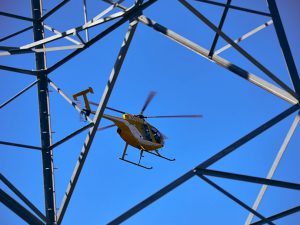
Tri-State Transmission and Generation uses air support to complete the Montrose-Nucla-Cahone transmission project. This project includes crossing the Dolores Canyon, which spans nearly 6,600 feet between two 85-foot-tall lattice towers, one each on the north and south rims of the canyon.
The Tri-State crossing effort required a span of nearly 6,600 feet between two 85-foot-tall lattice towers on the north and south rim of the canyon. When counting distances from the “dead ends,” which hold the weight of each of the five 20,000 pounds of conductor and optical ground wire tensions, the distance was 8,000 feet. The line dropped some 400 feet between the lattice towers into the canyon.
Tri-State made five crossings of the canyon: three with conductor and two with optical ground wire. A helicopter first pulled a 5/16-inch rope from the south to the north end of the canyon, and then winch equipment pulled back a 3/4-inch rope back to the south. At that point, the rope then pulled the conductor and optical ground wire back from the south to the north rim. This work started during the week of September 28 and was completed by October 10.
To put some of this in perspective, the transmission line over the Dolores Canyon spans about 1.25 miles between lattice towers and more than 1.5 miles between the dead ends. Only three other spans worldwide are known to be longer, although on much larger towers: an 8,714-foot span between the Jintang and Cezi islands in China; the crossing of the Norwegian Sognefjord at 15,082 feet; and the Ameralik Span in Greenland at 17,638 feet.
In fact, the Dolores Canyon segment wasn’t the only significant crossing.
Workers previously crossed Glade Canyon, 2.5 miles north of Dolores Canyon, which was a 2,800-foot crossing, or just over half a mile, and would have been a significant effort for any other transmission line project but now the second largest on MNC.
The Montrose-Nucla-Cahone transmission line project benefits
The MNC transmission line was energized in October and was complete — aside from reclamation work — by the end of 2020. The project cost nearly $105 million and required 65,000 labor hours for construction.
Completion of this project brings a number of immediate benefits to Tri-State and the bulk electric system. Greater reliability and lower maintenance needs, greater operational capacity and flexibility, and the ability to accommodate load growth in the area are just a few of the immediate impacts. MNC also paves the way for future benefits, including the ability to support Tri-State’s Responsible Energy Plan and the growing interest in generation interconnection projects throughout western Colorado.
Numerous departments and dozens of employees throughout Tri-State left their marks on this once-in-a-career project. Without the hard work and dedication of the MNC project team, none of the amazing numbers, accomplishments and benefits could have been achieved.
Jonah Martin is the manager of the Montrose-Nucla-Cahone project management office and an employee of Tri-State Generation and Transmission. Tri-State is a wholesale power supply cooperative, operating on a not-for-profit basis, with 45 members, including 42 utility electric distribution cooperatives and public power district members in four states that together deliver reliable, affordable and responsible power to more than a million electricity consumers across nearly 200,000 square miles of the West. For more information about Tri-State, visit tristate.coop.

